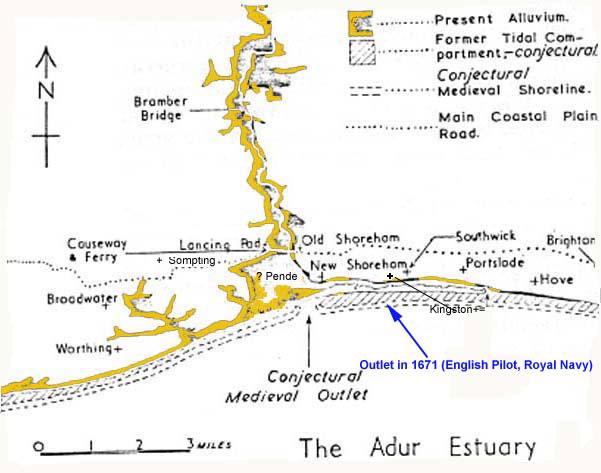Map reconstructing what Shoreham Harbour could have looked like in the 14th Century A.D. (It is ingenious rather than accurate.)
The Borough Seal featuring the 'hulc' , the most important trading vessel in Medieval times, is included in the bottom left.
The map shows Procession Street running through what was reconstructed
as the centre of the town. Historians may query this as Procession Street
is otherwise an important peripheral street in medieval towns.
 |
Alluvial muds which gives a good indication of the route of the river
and estuary in the past. Lagoons (like the Widewater
Lagoon) formed between the land and the sea, but the coastline was
not fixed and these would be altered and washed away by the sea.
Below the top layer of alluvium is a water-retaining sandy silt, known
as marsh clay. However, there is plenty of chalk in the banks of the river,
and this can be contrasted to the blue-grey of the marsh clay.
Alluvium is a general term for clay, silt, sand and gravel. It is the
unconsolidated detrital material deposited by a river, stream or other
body of running water as a sorted or semi-sorted sediment in the bed of
the stream or on its floodplain or delta.
History of the Adur Estuary (by H. C. Brookfield 1950-1)
Bramber Castle, now in ruins, was constructed by William de Braose about 1073. The initial fortification was an earthern motte, but later it was fortified with flint. (The date I have for a timber quay at Bramber is 1086).
William de Braose's Calendarium
Inquisit Post Mortem of 1094, which says:
'Shorham maner et castr' de Bramber baronia
Brembre maner et castr' extent' from
Simon
Stevens
The first bridge was wooden (c. 1103) and the later stone bridge constructed
over a substantial tidal stream.
The date of the stone bridge is not known, but it could have been built
between 1180 and 1190. (London Bridge started in wood, was rebuilt in stone
in 1179). Two bridges over the Adur at Bramber were definitely in existence
in about 1230.
The foundation of the stone bridge was of Sussex Marble (paludina
limestone) and the bottom course of cobbles (large pebbles from Shoreham
Beach).
The tidal inlet probably ran in two deep streams, the larger one on the western side.
Since then the reclamation of the tidal marshes, by a process called "inning", as well as a change in the coastline resulted in the silting up of the estuary. In 1232, floods could cause the bridge to be impassable.
In 1348 there is a church named St. Peter de Veteri Ponte, which may have been renamed St. Botolphs, in addition to a St. Peter church at Sele (Sele Priory), which is probably the church of St. Peter at Beeding.
In 1468, the stone bridge at Bramber (Between Bramber and Sele) is reported to be in bad repair.
By 1477-79, the deposition of silt was making navigation for sea going vessels under the Bramber Bridge impractical.
1622 Randall's
important map of Shoreham.
Sussex
Archaeological Society
Sussex
Archaeological Society EGroup